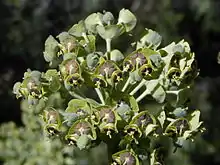Euphorbia characias
Euphorbia characias, the Mediterranean spurge[2] or Albanian spurge,[3] is a species of flowering plant in the family Euphorbiaceae typical of the Mediterranean vegetation. It is an upright, compact evergreen shrub growing to 1.2 m (3 ft 11 in) tall and wide.
| Euphorbia characias | |
|---|---|
 | |
| Scientific classification | |
| Kingdom: | Plantae |
| Clade: | Tracheophytes |
| Clade: | Angiosperms |
| Clade: | Eudicots |
| Clade: | Rosids |
| Order: | Malpighiales |
| Family: | Euphorbiaceae |
| Genus: | Euphorbia |
| Species: | E. characias |
| Binomial name | |
| Euphorbia characias | |
| Synonyms[1] | |
|
List
| |

Description
It has many woolly stems and characteristic black or dark brown nectar glands in the cyathia, which are borne in dense spherical clusters, from spring to early summer.[4] The fruits are smooth capsules. It is a tough plant, capable of resisting long periods of drought. It grows preferably in dry areas, often far away from the water table, both in flat as well as in mountainous terrain. This plant can also resist high salinity.[5]
Subspecies
Two main subspecies are found in different regions of the Mediterranean Basin. These often overlap in the western areas of distribution:
- E. characias subsp. characias (s). From Portugal to Crete
- E. characias subsp. wulfenii (Hoppe ex W.D.J.Koch) Radcl.-Sm. 1968 (s). From Southern France to Anatolia.
Cultivation
Euphorbia characias is valued as an ornamental plant for its ability to survive drought and its groundcovering capabilities. It is suitable for any location, sheltered or exposed, in light soil in full sun. It is fully hardy down to −10 °C (14 °F).[4]
Cultivars
Garden cultivars are sold under the names ‘Black Pearl’, ‘Thelma's Giant’, ‘Lambrook Gold’, ‘Silver Swan’ and ‘Tasmanian Tiger’, among others. They come in a variety of colors, from silvery grey and bluish green to greenish yellow. These garden varieties are valued in Mediterranean or desert landscaping for not being highly demanding and for looking good despite lack of watering in sunny areas.[6]
The following cultivars have gained the Royal Horticultural Society's Award of Garden Merit:-[7]
Uses
This plant also has uses in traditional medicine; like many other species of genus Euphorbia[12] its toxic white and sticky sap has been used to treat skin excrescences, like cancers, tumors, and warts, since ancient times.
Gallery



 (with Jacobaea maritima)
(with Jacobaea maritima)
References
- "The Plant List: A Working List of All Plant Species".
- "BSBI List 2007". Botanical Society of Britain and Ireland. Archived from the original (xls) on 2015-01-25. Retrieved 2014-10-17.
- "Euphorbia characias". Natural Resources Conservation Service PLANTS Database. USDA. Retrieved 26 April 2015.
- RHS A-Z encyclopedia of garden plants. United Kingdom: Dorling Kindersley. 2008. p. 1136. ISBN 978-1405332965.
- "Espècies d'habitats allunyades del freàtic". Archived from the original on 2011-07-10. Retrieved 2010-10-05.
- "Mediterranean Landscaping". Archived from the original on 2011-07-14. Retrieved 2010-10-05.
- "AGM Plants - Ornamental" (PDF). Royal Horticultural Society. July 2017. p. 38. Retrieved 23 February 2018.
- "RHS Plantfinder - Euphorbia characias 'Tasmanian Tiger'". Retrieved 26 February 2018.
- "RHS Plantfinder - Euphorbia 'Whistleberry Garnet'". Retrieved 26 February 2018.
- "RHS Plantfinder - Euphorbia characias subsp. characias 'Blue Hills'". Retrieved 14 February 2018.
- "RHS Plantfinder - Euphorbia characias subsp. wulfenii 'Jimmy Platt'". Retrieved 26 February 2018.
- Lletereses (in Catalan)
- Seidel, Denkwart. Blumen am Mittelmeer, München 2002, ISBN 3-405-16294-7
External links
| Wikimedia Commons has media related to Euphorbia characias. |